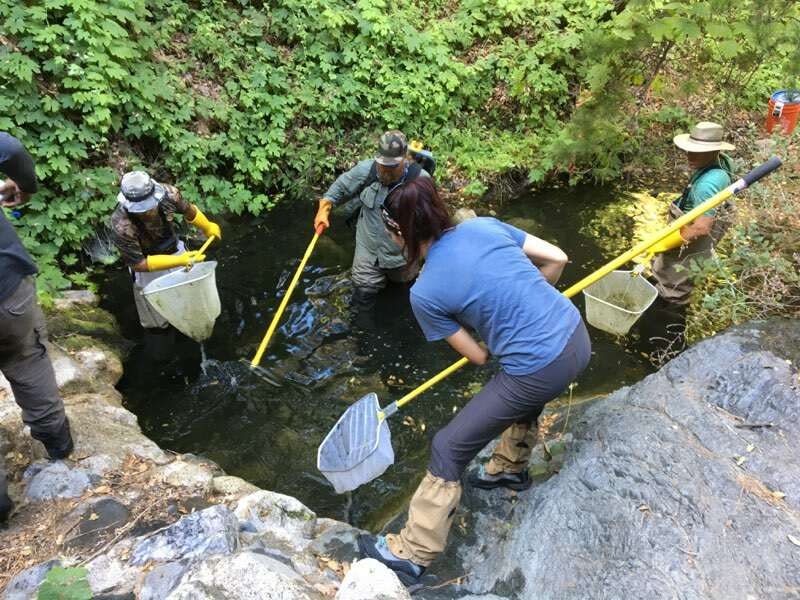Native Fish Studies and Propagation
LandUse Learning Center Stream and Raceways
.jpg?ixlib=rb-1.1.0&w=2000&h=2000&fit=max&or=0&s=cff45f82cae25bccb6b2f0c3dbb06ffa)
In 2000, the District constructed a specially designed stream at the LandUse Learning Center that supports a native fish population of Speckled Dace, Arroyo Chub, and Santa Ana Sucker, a threatened species. The number of fish varies from year to year, depending on natural reproduction. The recirculating, 300-foot long stream was constructed to replicate a small tributary to the Santa Ana River.
The RCRCD’s seven 100 foot-long raceways have been used for the breeding and study of native fish, in cooperation with the California Department of Fish and Wildlife (CDFW)- Region 5&6, the US Fish and Wildlife Service (FWS), and the US Geological Survey (USGS).
Greenbelt Aquatics Facility

The District is developing an aquatic research and native fish breeding facility in the Agricultural Greenbelt area of Riverside. The construction of new raceways at the Greenbelt property will increase capacity to safely hold, rear, and study native fishes, as well as provide greater refugia for rescued fish, frogs, and pond turtles that may be extirpated from their native habitat due to catastrophic floods, drought, fire or other unforeseen conditions.
Much of the project is part of the Upper Santa Ana River Habitat Conservation Plan (SAR HCP), which is being funded by local water districts. Under the plan, the RCRCD will create conservation easements on some of the lower tributaries of the river in order to conserve and manage essential habitat that fish rely on during warm water conditions and flooding, and at smaller backwaters where fish can find refugia. Fish propagated at the facility will be released into tributaries of the Santa Ana River where Santa Ana Suckers and other native fish were once common.
Temescal Wash

The RCRCD was awarded the American Fisheries Society Award of Excellence in Riparian Management in 2010 for its work in Temescal Creek near the City of Corona, CA. The Temescal Creek Native Fish Restoration Project was conducted over a three-year period and included the removal of non-native plants and animals, such as crawdads, bullfrogs, bullhead catfish, and Red-eared slider turtles. Many of these pests were originally released as pets or bait, but have since become “naturalized” and compete with native plant and animal populations. Restoration efforts, such as dip netting and re-establishment of native plants, help to improve habitat for native fish, amphibians, and aquatic reptiles. Arroyo chub were once common in the area, but have been extirpated in most streams due to these exotic predators.
Riverside Waterways

The RCRCD continues to work with local water districts, (San Bernardino Valley Municipal Water District, Western Municipal Water District, Riverside Public Utility), US Fish and Wildlife Service, California Department of Fish and Wildlife, and the City of Riverside on the restoration of the lower Tequesquite Arroyo for the benefit of the Santa Ana Sucker. The creek was degraded due to trash, exotic plants, and barriers to water flow. The five-year project involves removing exotic species, controlling erosion on channel banks, placing substrate onto the channel bottoms to create spawning habitat, and planting of native vegetation. The Santa Ana River Restoration/Recovery Trust Fund (held by San Bernardino Valley Municipal Water District) provided $125,000 to restore native fish habitat in the lower Tequesquite Arroyo.
Coldwater Creek

The RCRCD Coldwater Creek property is an 80-acre upland-riparian site that has a breeding population of genetically pure steelhead, or coastal rainbow trout. These fish once swam to the ocean, but dams, flood control projects, and changes in stream hydrology prevent migration. The District monitors creek water quality; fish population dynamics; and streamside habitat in cooperation with the CDFW each month. Ongoing surveys and monitoring will be conducted by the RCRCD in order to manage the fish population and prevent decline, loss in numbers or extirpation.



